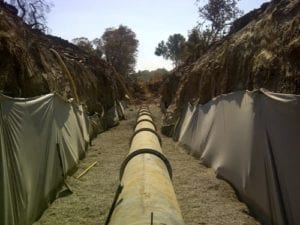At the beginning of 2012, construction commenced on Phase 2B of the augmentation of Pretoria’s Moreleta Spruit Outfall Sewer network. The City of Tshwane contracted Aurecon, a global engineering company, to design and plan this substantial project.
Subterranean water posed problems in certain areas, such as in the leafy suburb of Moreleta Park, where the new pipeline would have to traverse wetlands. The instability of the clay soil here posed a further problem as it was essential that the pipes be installed on stable platforms and that the crushed stone bedding layers were kept free of silt. It was at this stage of the design process that Aurecon specified Kaytech’s bidim A4 geotextile to help alleviate these problems. Bidim has the highest possible throughflow rate while providing excellent filtration characteristics. In sub-soil drainage, as required in this project, bidim performs two functions – filtering and separating soils. The contract was awarded to VF Munisi Civils, which installed the pipes according to Aurecon’s design: the trenches were dug far larger than the diameter of the pipes, lined with bidim A4 followed by a series of crushed stone layers to form a base. Once the pipes were positioned onto this stone layer, the trenches were filled with stone and subsequently closed with an overlap of bidim.Since 1971, Kaytech began supplying the civil engineering industry with its non-woven continuous filament needle-punched polyester bidim geotextile. In 1978, it began manufacturing geotextiles from 100% polyester, much of which is supplied through recycled cool drink bottles. This formula provides distinct advantages over other man-made fibres: improved modulus of deformation, enhanced plastic yield stability, higher breaking strength and superior wettability.
The mechanical process of needlepunching allows for an appreciable thickness of the geotextile as well as high porosity, high drainage capacity (both within and normal to the plane), good resistance to damage, and a flexibility that aids installation. Although this project is not scheduled for completion until early2014, the problem appears to have been solved. The final success of the application will only be determined once the pipeline is fully operational; however, Kaytech believes that its high performance, top quality bidim will prove its efficacy.







